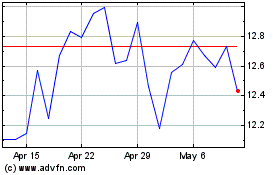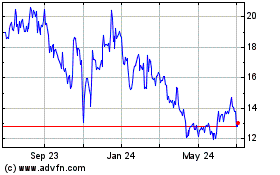Cost Of Cotton May Lead Apparel Companies To Raise Prices
September 29 2010 - 3:31PM
Dow Jones News
Cotton's march past $1 a pound will prompt many apparel makers
and retailers to mitigate the extra manufacturing cost with price
increases, despite continuing signs of belt-tightening among
consumers.
Price increases are a "tool everyone will implement," said
Kenneth Stumphauzer, a Sterne, Agee & Leach analyst.
Uncooperative weather in key cotton-producing regions has
squeezed inventories since the beginning of the year. Prices rose
as cotton fields flooded in Pakistan, and heavy rains in China, the
world's No. 1 grower and importer, threatened planting acreage and
the harvest. Export quotas in India and Brazil only exacerbated the
supply issues.
Yet certain companies will be able to shoulder higher cotton
costs more easily than others.
Those, like Gildan Activewear Inc. (GIL, GIL.T) and Hanesbrands
Inc. (HBI), that manufacture such all-cotton products as socks,
T-shirts and underwear will have less wiggle room in their cost
structures. Others, like VF Corp. (VFC) and Warnaco Group Inc.
(WRC), manufacture clothing with man-made fiber and cotton blends
and may not face the same pressures.
For Gildan, whose signature products include blank cotton
T-shirts, the commodity is a larger component of costs than it is
for some of its peers. When cotton hovered around 65 cents a pound,
it represented about a third of Gildan's cost of goods sold, Chief
Financial Officer Laurence Sellyn said. As cotton prices rise, that
portion will increase.
The company raised prices through its wholesale channel in July
and again in September, a cumulative bump of about 6%. Sellyn
confirmed that price increases in the second half of fiscal 2011
are "realistic" if cotton stays at current levels.
Still, Gildan may be better poised to handle cost increases due
to its lower overhead for labor. The company has manufacturing
sites in Central America and the Caribbean basin, which helps it
duck the panoply of woes facing Asian manufacturers: currency and
wage increases, labor shortages and high transportation costs,
among others.
Moreover, Gildan has locked in cotton prices six to nine months
in advance, so its costs don't reflect current cotton prices. The
company set prices for the upcoming December quarter at just below
80 cents a pound, and targets March-quarter prices in the low- to
mid-80-cent range.
As for Hanesbrands Inc. (HBI), cotton makes up a little more
than 10% of its cost of goods sold and contributes to about 7% to
8% of sales, according to Sterne, Agee's Stumphauzer. The company
will have to implement a price increase of 2% to 3% to offset the
rising cost of cotton, he said, and won't get pushback from
retailers.
The company wasn't immediately available for comment but in July
said that, due to high cotton, energy and labor costs, it would
raise prices in the third and fourth quarters of 2010, with the
majority of price boosts beginning in 2011.
On the retail side, Abercrombie & Fitch Co. (ANF) may not be
able to deal with price increases as gracefully as others. Its
eventual concession to mark down clothing was a boon for sales in
the recession, so reverting to higher prices won't likely be the
company's impulse fix-it for high cotton costs. Still, cost cuts
over the past year may help.
Given Abercrombie's "clout," it likely won't use cheaper fabrics
and therefore risk quality, said Robert Samuels, an analyst at
Phoenix Partners Group.
The coup de grace could be cotton prices' eventual reversion
back to the mean, with near-term prices possibly returning to a
low-90-cent range. High prices in September are "extraordinarily
rare literally right in front of the harvest," said Sharon Johnson,
a cotton analyst at First Capitol Group in Atlanta. With about
747,000 bales picked and ginned, U.S. production is already about
two to three times higher than in the three previous years, and a
month from now supply will look "very, very different," said
Johnson.
-By Rachel Rosenthal, Dow Jones Newswires; 212-416-2263;
rachel.rosenthal@dowjones.com
VF (NYSE:VFC)
Historical Stock Chart
From Mar 2024 to Apr 2024

VF (NYSE:VFC)
Historical Stock Chart
From Apr 2023 to Apr 2024
